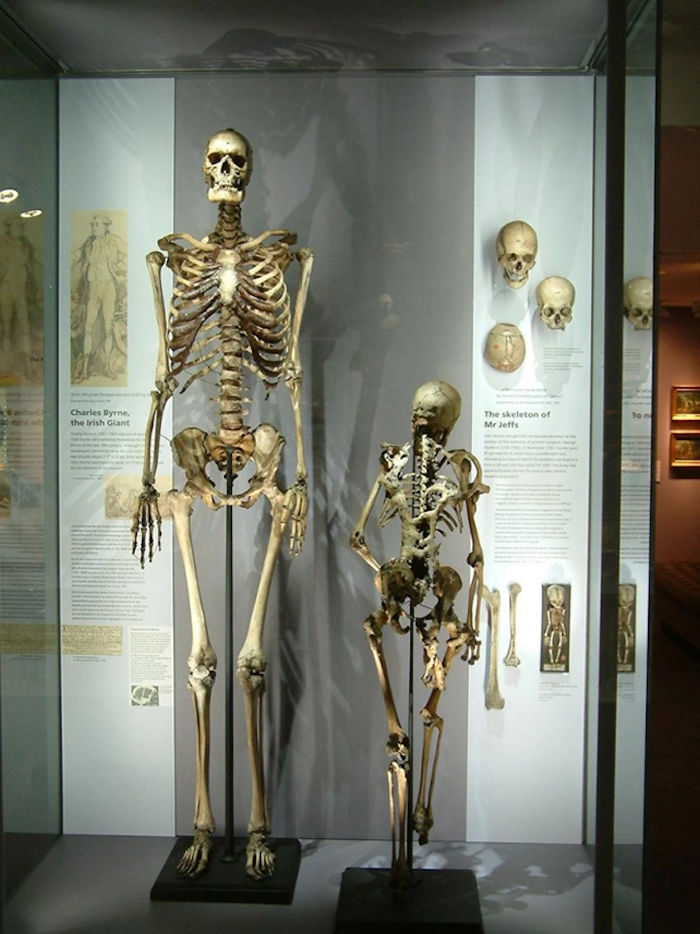Jan Bartek - AncientPages.com - It has been decided the skeleton of the Irish Giant Charles Byrne will not be part of the controversial exhibition at the Hunterian Museum in London, UK.
With the approval of the Council of the Royal College of Surgeons of England, the Trustees agreed that instead, the skeleton will be retained as it is an integral part of the Hunterian Collection and will be available for bona fide research into the conditions of acromegaly and gigantism.
The Charles Byrne skeleton on display. (Doyal and Muinzer, The BMJ, 2011)
It was also decided a new program called Hunterian Provocations will begin in the autumn of 2023 to promote new research and explore issues around the display of human remains and the acquisition of specimens during British colonial expansion.
Charles Byrne was born in Littlebridge near Lough Neagh in the north of Ireland in 1761. He lived with the conditions known today as acromegaly and gigantism.
He grew to be 7’7’’ (2.31m) tall and in the last years of his life made a living exhibiting himself as the ‘Irish Giant’ in Edinburgh and London. He died in 1783 and it was said that to prevent his body being seized by anatomists he wanted to be buried at sea.
Unfortunately, his wishes have not been respected.
Before Byrne could be buried John Hunter intervened and is reported to have paid Byrne’s friends £500 for his body. Three years later Hunter displayed Byrne’s skeleton in his Leicester Square museum and part of it is shown in the background of the portrait of Hunter by Sir Joshua Reynolds.
What Makes The Skeleton Of Charles Byrne Such An Important Osteological Specimen?
Osteo means bone (as in osteoarthritis) and osteology is the study of the form and function of bones. In basic anatomy, the skeleton is the foundation of learning about animals’ bodies.
The skeleton of Charles Byrne who had an undiagnosed benign tumor of his pituitary gland, an adenoma, which caused acromegaly and gigantism
is the best-known human anatomical specimen in the collection of 18th-century surgeon anatomist John Hunter.
Charles Byrne’s skeleton is a very rare specimen in the Hunterian collection, the largest anatomy collection in England to survive from the 18th century.
Why Will Charles Byrne's Skeleton Not Be Displayed In The New Hunterian?
During the five-year period of closure of the Hunterian Museum, the Board of Trustees of the Hunterian Collection reviewed and discussed the sensitivities and the differing views surrounding the display and retention of Charles Byrne’s skeleton. The Trustees, with the approval of the Council of the Royal College of Surgeons of England, agreed that
Charles Byrne’s skeleton will not be displayed in the new Hunterian Museum.
The skeleton will be retained as it is an integral part of the Hunterian Collection and will be available for bona fide research into the conditions of acromegaly and gigantism.
Has The Royal College Of Surgeons Of England Chosen To Ignore Charles Byrne’s Last Wishes?
According to the news statement, decisions about the display and care of the Hunter collection rest with the Board of Trustees of the Hunterian Collection, appointed by the British Government in 1799, and not directly with the Royal College of Surgeons of England.
The anecdotal references to Charles Byrne’s wishes are well documented, although no written evidence exists.
The Trustees of the Hunterian Collection recognize the sensitivities and the differing views surrounding the display and retention of Charles Byrne’s skeleton.
The importance of Hunter’s Collection rests in its entirety. The skeleton of Charles Byrne is an integral part of the collection (RCSHC/osteo 223) and is therefore covered by these conditions.
Byrne in a John Kay etching (1784), alongside the Brothers Knipe and dwarfs. Credit: Public Domain
*The responsibilities of the Corporation of Surgeons (later the Royal College of Surgeons of England) and the Board of Trustees of the Hunterian Collection were set out in the Terms and Conditions of 1799:
Paragraph 3 ‘That the preparations shall be kept in a state of Preservation, and the collection in as perfect a state as possible, at the Expense of the Corporation of Surgeons, subject to the annual inspection and superintendence of the Trustees’.
Where Will The Skeleton Be Stored If It Is Not Displayed In the Museum?
The skeleton is kept in store at the Royal College of Surgeons of England at Lincoln’s Inn Fields under Department for Culture, Media & Sport (DCMS) guidelines on best practice for the care of human remains.
What Sort Of Scientific Research Will Be Carried Out On Charles Byrne’s Remains?
In the press statement, the Royal College Of Surgeons of England explained. "We cannot foresee the ways in which gene and bone analysis technologies may develop that could allow greater understanding of the causes of pituitary acromegaly and gigantism.
Previous research was undertaken in the early 20th century by the American pioneer of neurosurgery Harvey Cushing. In the early 21st century, DNA analysis by endocrinologist Professor Marta Korbonits and her team at Queen Mary University of London linked a living person with pituitary acromegaly and Charles Byrne through a common ancestor.
When Will future Multidisciplinary Projects Be Undertaken?
In the autumn of 2023 RCS England Museums will launch a new programme of research, collaborations and events called ‘Hunterian Provocations’ which seeks to address issues surrounding the display of human remains and the practice of acquisition of specimens for museums, power imbalances and the exploitation of peoples and natural environments during British colonial expansion."
Written by Jan Bartek - AncientPages.com Staff Writer







